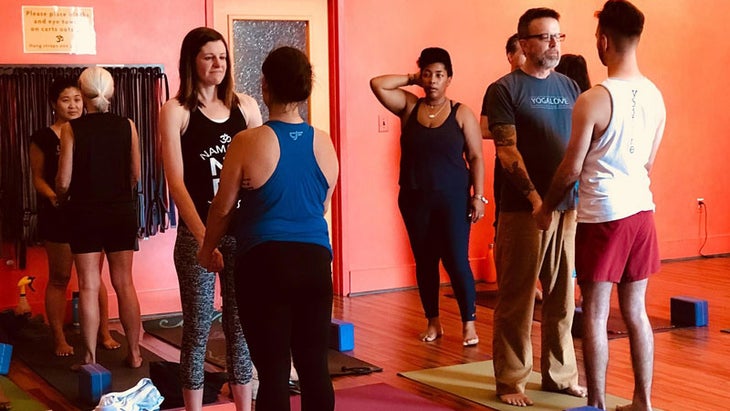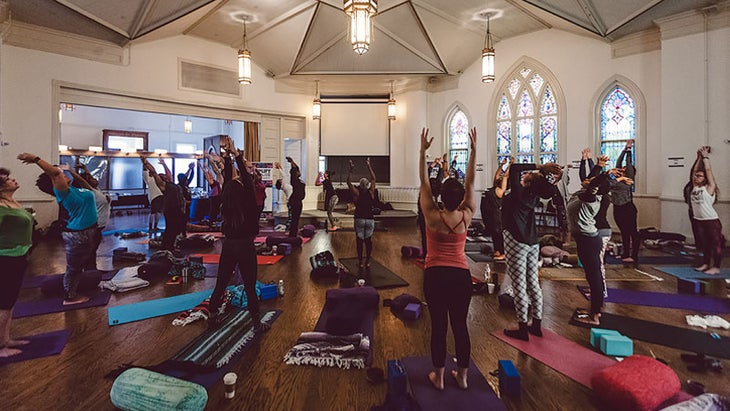Heading out the door? Read this article on the new Outside+ app available now on iOS devices for members! Download the app.
Live Be Yoga ambassadors Jeremy Falk and Aris Seaberg are on a road trip across the country to share real talk with master teachers, explore innovative classes, and so much more—all to illuminate what’s in store for the future of yoga. Follow the tour and get the latest stories @livebeyoga on Instagram and Facebook.
While in Charlotte, we attended an eye-opening event that for the first time in the area brought together local studios, teachers, students, and community activists to discuss ethics in yoga. Activist and local teacher Jasmine Hines created Amplify and Activate, a series of summits to “uplift the voices that aren’t normally heard” in the yoga community. What began as a conversation around #metoo ultimately addressed a lack of inclusivity in mainstream yoga studios that has led many community members to practice in other spaces. Panel members and participants shared their pain, vulnerability, and courage, while powerfully demonstrating how to truly live and be yoga by applying the principles of the practice to address these challenging issues.
Before the discussion began, co-organizer of the summit Grace Millsap and activist Kelley Carboni-Woods (both local teachers) led a slow, sweet, and accessible class that utilized asana and partnered eye-gazing to transition into a more receptive place of listening and understanding. They mitigated expectations of the evening by clarifying that the intention was less about solving problems and more about opening the doors to change. “The teachings of yoga help facilitate difficult conversations, because they invite us to go into the space that’s not comfortable,” said Millsap, “and what blossoms out of that is understanding, truth, acceptance, and all-around unity—the true meaning of yoga.”

After the practice, the panelists began discussing abuse in the yoga community, and eventually the topic shifted as Carboni-Woods spoke up about the fractured yoga community in Charlotte. It forced us to open our eyes and see beyond our own white and able-bodied lenses of privilege when we discovered that there were a significant number of students with larger bodies, people of color, yogis with disabilities, and seniors who were practicing outside yoga studios because they didn’t feel supported or empowered in many mainstream yoga classes.
Carboni-Woods, who teaches packed classes in alternative spaces, feels that these groups have been marginalized by underrepresentation in both yoga media and yoga studios, whose advertising doesn’t reflect that diverse populations are welcome and perpetuates the idea that yoga is only for thin white women with disposable income. Also, studios offer “all levels” classes that are more concerned with “selling asana and getting bodies in the door” but aren’t always appropriate for all bodies, Carboni-Woods said. Studios can only benefit from having “more tools around helping bigger bodies into the poses as well as some investigation into who [their offering] is really for.”
We reflected deeply on this and committed ourselves finding ways to diversify our offerings and create more inclusivity. I know I’ve contributed to this problem by teaching classes labeled as “all levels” that were too athletic in nature to be suitable for every level of practitioner. I’ve always felt conflicted with the accuracy of such a description, and I can’t think of any subject matter in academia that is taught this way. I imagine a 60-minute “all levels” math class claiming to be suitable for students learning addition and subtraction as well as those working through advanced trigonometry. Eventually one of the groups won’t feel addressed, and this contributes to the lack of inclusivity. According to Millsap, one of the ways studios can amend this issue is to diversify the types of classes offered. “Be clear on what level of practitioner the class is appropriate for. It will send a message that all people can come into the space,” she said.

At the end of the summit, though the problems weren’t solved, a sense of relief came from voicing the issues and beginning to ask the right questions. How can we further increase the inclusiveness of yoga? Aris and I wish to use the platform we have with Live Be Yoga to highlight the stories and voices of those that are underrepresented in mainstream yoga. Aris is also inspired to study trauma-informed teachings and support healing for all while I am eager to support more men stepping onto the mat to grow a mindful masculine presence on the planet. As Millsap said, “It definitely starts with the teachers and how they’re trained.” From there, we can start to address the entire scope of human shapes, sizes, and colors often unacknowledged in the yoga community. “It’s like it doesn’t exist,” said Hines, “so we’re here to make you know it exists.”
Charlotte has made it clear that the future of yoga is inclusive. Get information on the local panels on the Amplify and Activate Facebook page here. If you’re ready to initiate these conversations in your community, Hines and Millsap are more than willing to come to your city and help organize a summit. Find them at amplifyandactivate.com.